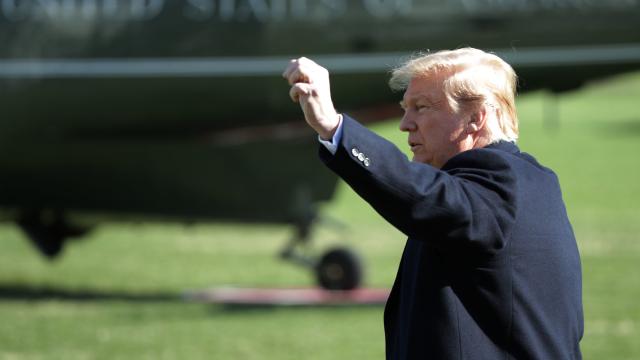President Donald Trump ratcheted up the drama over the Keystone XL Pipeline Friday when he issued a presidential memorandum to push the oil pipeline through despite a recent court ruling against it. And opponents plan on taking him back to court over it. After all, his action could set a new precedent for presidential power over such infrastructure if he gets away with it.
The Keystone XL Pipeline has lost and gained approval over and over again under separate administrations and lawsuits. Most recently, the proposed 1,897km long pipeline from Alberta, Canada, to Nebraska was put on pause in November after a federal district court judge concluded the project’s environmental impact analysis failed to properly assess its impacts on the climate, the impacts of potential oil spills, and more—all issues that need attention under the National Environmental Policy Act (NEPA).
The judge ordered the State Department to redo that analysis.
Now, Trump is telling Judge Brian Morris to go screw himself. This new presidential permit is supposed to replace one the president issued just days after taking office in 2017 — and the president is asserting that NEPA doesn’t have power over this permit the way it did over the last one.
This is where things grow complicated.
You see, when Trump issued a federal permit for the pipeline in 2017, he delegated authority over that process to the State Department. That permit sought federal regulatory approval and input from the public and federal agencies. This time around, however, the president is not involving anyone else.
The new permit is issued simply “by the authority vested in [Trump] as President of the United States of America.” This move is unprecedented, said Doug Hayes, a senior attorney with the Sierra Club, who is helping litigate the case.
“It’s pretty clear that this new permit was an attempt to circumvent the court’s rulings and the environmental laws altogether,” he told Earther. “This is the first time at least since 1968 that a president has tried to just avoid all that altogether.”
The legality of the president’s action—of backtracking, cancelling a previous permit, replacing it with a new one, and ignoring a court ruling—isn’t immediately clear. That’ll likely be something for the courts to figure out, said Daniel Rohlf, a law professor at the Lewis & Clark Law School. Then, there’s the question of whether NEPA applies to such a presidential action. The president definitely doesn’t think so, which is probably why he took this route.
“That’s the legal tool the president is using,” Rohlf told Earther. “It’s clear that the White House believes that it can go around that earlier executive order” and say the president can unilaterally decide whether or not to issue a permit.
Hayes wouldn’t offer specifics on the legal response opponents to the pipeline have planned, but he and his colleagues are currently assessing what step makes the most sense. In the meantime, he said TransCanada, the developer, can’t begin any construction without properly filing a motion on the ongoing case over the previous presidential permit.
However, Dallas Goldtooth, a campaign organiser at the Indigenous Environmental Network (IEN), a Native-led group that’s a plaintiff in this lawsuit, said there is concern the company will use Trump’s decision as a green light to jumpstart work on the project. So community members are monitoring the pipeline route in South Dakota and Montana to see whether the company is bold enough to do so.
In Nebraska, the other state the pipeline will cut through, the project is being contested before the state Supreme Court in a separate lawsuit over the state’s approval of the route.
That decision is expected any day now, and it’ll determine whether state officials have to re-assess the current route or whether Keystone XL is good to go in Nebraska. It’s unclear how Trump’s presidential permit affects the project’s status there.
Indigenous opponents are ready no matter what happens. Goldtooth calls the president’s action “illegal and extremely dangerous to not only the communities fighting this project but to the checks and balances of our democracy itself.”
“Trump knows that he’s been in a losing battle against us in the fight in trying to get Keystone XL approved,” he told Earther. “This is another desperate action by the president to get this project moving.”
As chance would have it, the president’s decision comes just days after South Dakota Governor Kristi Noem signed two protest bills into law that would target funding that goes toward protests. These protest laws follow the mass mobilizations at Standing Rock against the controversial Dakota Access Pipeline in 2016.
The state American Civil Liberties Union is suing the governor, along with groups like IEN, for allegedly violating free speech.
Trump is determined to make this pipeline happen, and he’s got allies on the local level. That doesn’t mean opponents will sit back and allow Keystone XL to enter their backyards without a fight.
